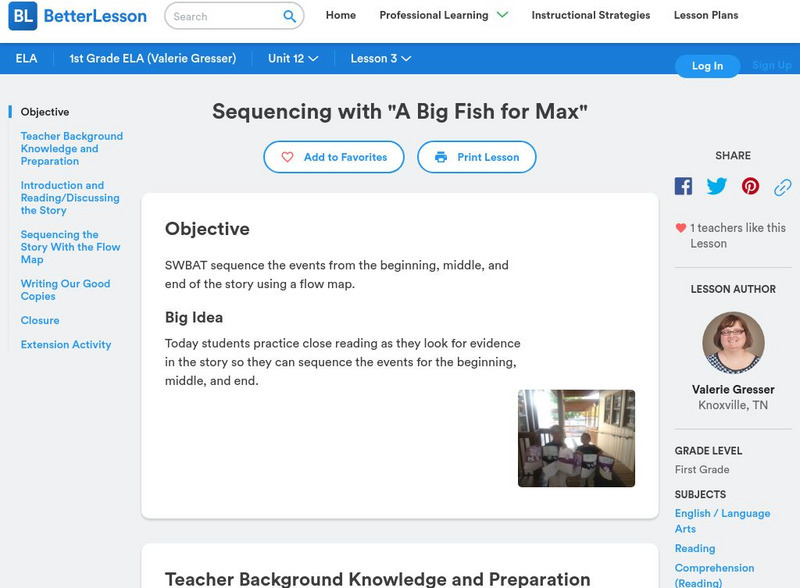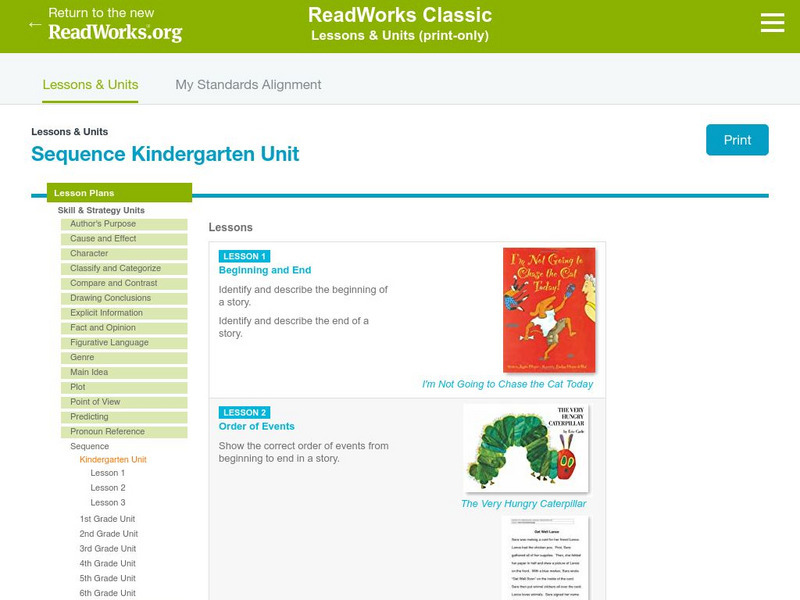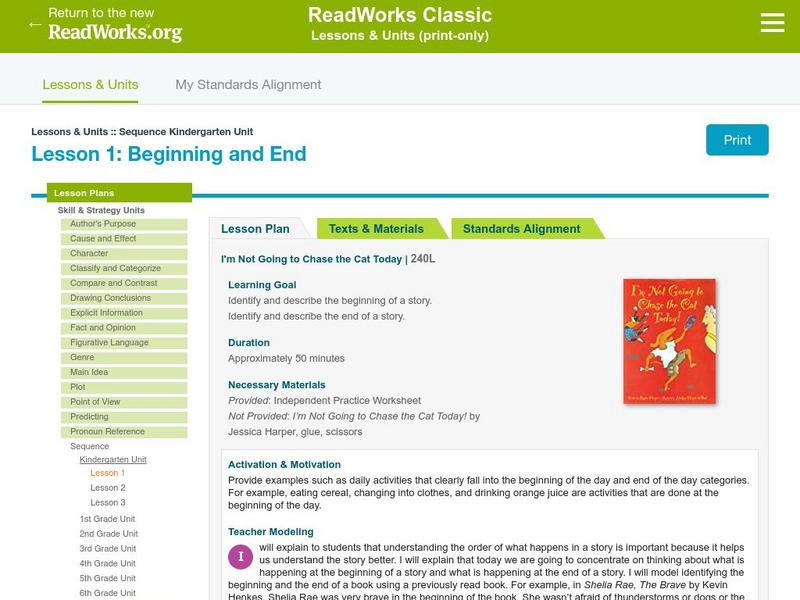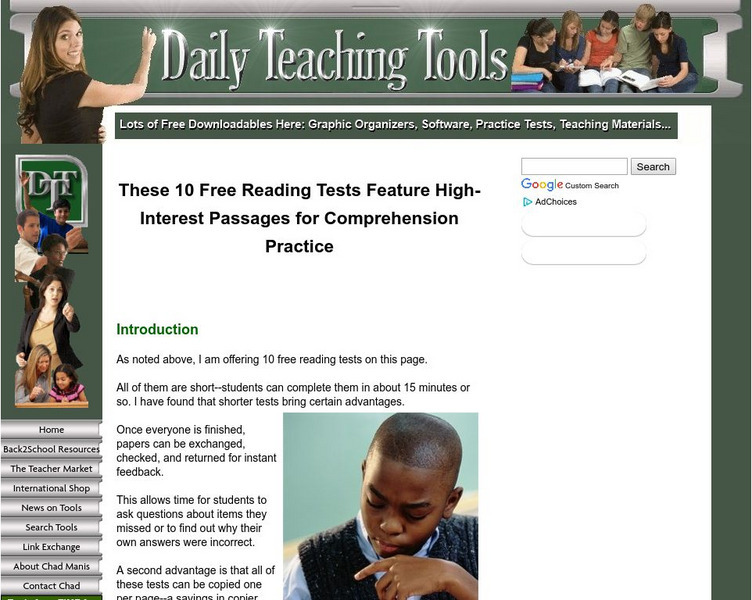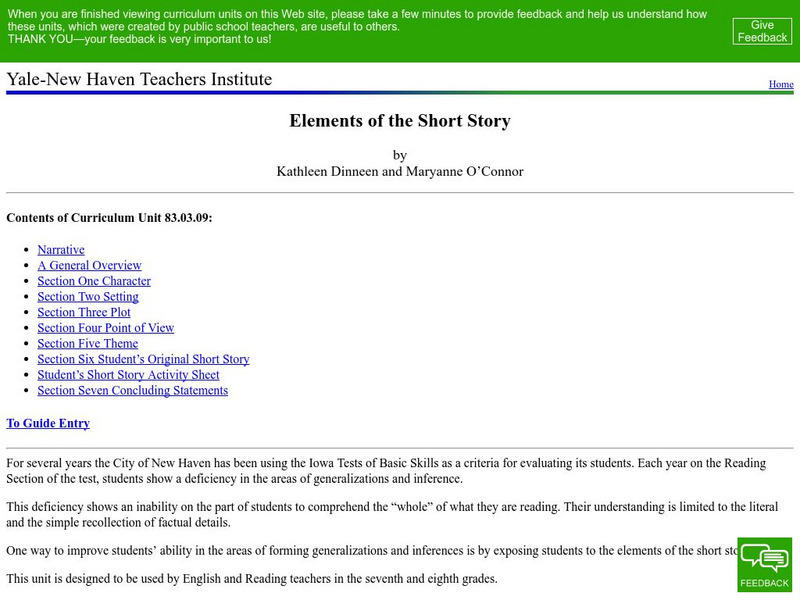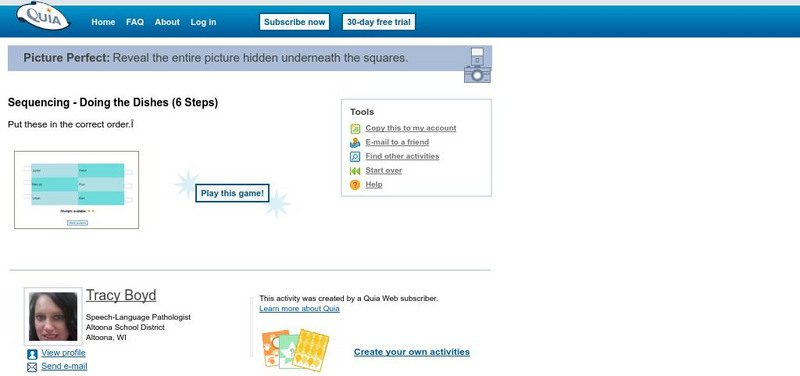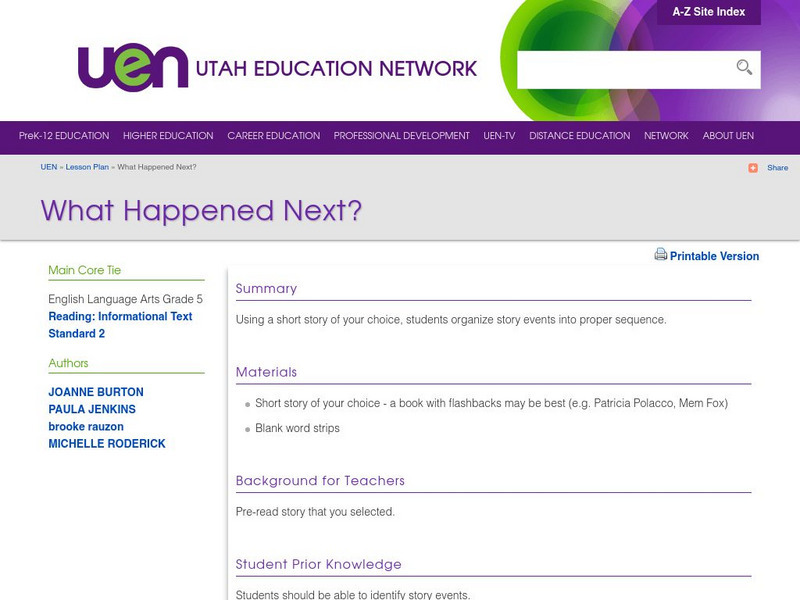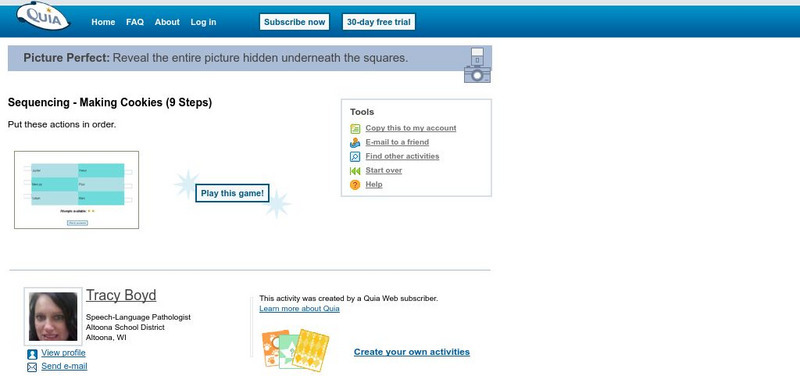Florida Center for Reading Research
Florida Center for Reading Research: Narrative Text Structure: Sequence a Story [Pdf]
A lesson plan in which students read a narrative text and write the main events of the story on sentence strips. Materials are included.
Learning Farm
Learning Farm: Ccs: Time, Sequence, and Cause/effect
An automated lesson will engage student's learning how to describe the connection between a series of historical events, scientific ideas or concepts, or steps in technical procedures in a text. An introduction to the concept precedes a...
Read Works
Read Works: Colorful Crayons
[Free Registration/Login Required] An informational text giving facts about crayons and how they are made. A question sheet is available to help students build skills in sequencing.
Beacon Learning Center
Beacon Learning Center: Sequence of Events
Build sequencing skills by looking at transition words like first, next, then, and finally. Read four short paragraphs and use the transition clues to put the events in the correct order. Then use these words while typing an original...
Beacon Learning Center
Beacon Learning Center: Sequence of Events
Practice putting pictures and story events in order after reading a short text in this online learning activity.
Utah Education Network
Uen: Sequencing a Story
This single-period lesson reinforces the concept of story sequence. Teachers of this lesson will read aloud Enemy Pie, by Derek Munson, How to Make An Apple Pie and See the World by Marjorie Priceman. Then students will participate in...
Texas State Historical Association
Texas State Historical Association: Depression to Prosperity [Pdf]
An activity guide where students refer to the Texas Almanac, which is free to download, for information needed to complete assigned tasks. In this lesson, they read about important events through the 20th century in Texas, answer...
Better Lesson
Better Lesson: Sequencing With "A Big Fish for Max"
Today students practice close reading as they look for evidence in the story so they can sequence the events for the beginning, middle, and end.
Read Works
Read Works: Sequence Kindergarten Unit
[Free Registration/Login Required] A series of three lesson plans designed to teach students to recognize the beginning and ending of a story and use word clues to put story events into the correct sequence. Lessons are based on the...
Read Works
Read Works: Sequence Kindergarten Unit: Beginning and End
[Free Registration/Login Required] This webiste provides a instructional activity in which learners identify and describe the beginning and end of a fiction story. Lesson includes ideas for direct teaching, guided practice, and...
Better Lesson
Better Lesson: Tie It Up With Transition Words to Write a Story!
Read, write, and present a digital narrative with transition words to help us put the events in order! After modeling the lesson, groups of learners will write narratives to recount a short sequence of events, they will include details...
Daily Teaching Tools
Daily Teaching Tools: 10 Free Reading Tests for Comprehension Practice
This Daily Teaching Tools resource provides ten short reading comprehension quizzes. Students will be able to write a sequence of events more efficiently by using this tool. All questions are skill-based and vary in levels of readability.
Better Lesson
Better Lesson: Emergent Readers With and Emergent Reader
Students will sequence story events with the teacher and read an emergent reader in a guided setting. The chosen book, "Pilgrims and Wampanoag: Together They Were Better", has high use of sight words and high levels of picture support...
Annenberg Foundation
Annenberg Learner: Elements of a Story Interactive
Explore different ingredients, or elements, that go into stories and make them so much fun. Read the story, "Cinderella," and look at all the different pieces of the tale to see how they all fit together.
Alabama Learning Exchange
Alex: Fun With Seasons!
In this lesson students will learn about proper sequencing of events while also learning about our four seasons. We will be reading the book, The Apple Pie Tree and will be discussing each season prior to our reading. The students will...
Yale University
Yale University: Elements of the Short Story
This unit from the Yale University on elements of the short story is designed to develop student comprehension skills, particularly making inferences and generalizing. It also involves students in reading a number of short stories to...
Alabama Learning Exchange
Alex: The Grouchy Ladybug
The students will thoughtfully listen to a story read aloud and comprehend the sequence of events. This lesson will culminate units completed in science and math and will incorporate literature, science, and math.
Quia
Quia: Doing the Dishes
In this game, students are to read all nine steps to making homemade pizza and then number them in chronological order to reveal a hidden picture. Java is required.
Utah Education Network
Uen: What Happened Next?
In this lesson, 5th graders will read informational text articles. Then students place sentences from the articles into chronological order.
ClassFlow
Class Flow: Retelling the Story
[Free Registration/Login Required] This flipchart helps to teach students how to retell main events from a story and sequence events.
Quia
Quia: Making Homemade Pizza (9 Steps)
This activity aims to improve student understanding of sequencing. Students put eight actions in order to emphasize understanding and application of sequential order.
Quia
Quia: Making Cookies (9 Steps)
This activity is designed to increase student understanding of sequencing. Activity encourages students to put six actions in order to emphasis understanding and application of sequential order.
Better Lesson
Better Lesson: Procedural Text: Recipe
A teacher created lesson plan to help students conquer how to make connections between directions in an effort to create something. This activity will have students sharing recipes and understanding why recipes should be followed in...
Alabama Learning Exchange
Alex: Aunt Chip and the Triple Creek Dam Affair
In this lesson, students will read and summarize the book by pages. After publishing, students will use their slides as sequencing exercises. This lesson plan can be adapted for any grade level or book.
![Florida Center for Reading Research: Narrative Text Structure: Sequence a Story [Pdf] Lesson Plan Florida Center for Reading Research: Narrative Text Structure: Sequence a Story [Pdf] Lesson Plan](https://content.lessonplanet.com/knovation/original/509124-8f3f3c440d6b6d200b605de1c46e8d0a.jpg?1661786936)
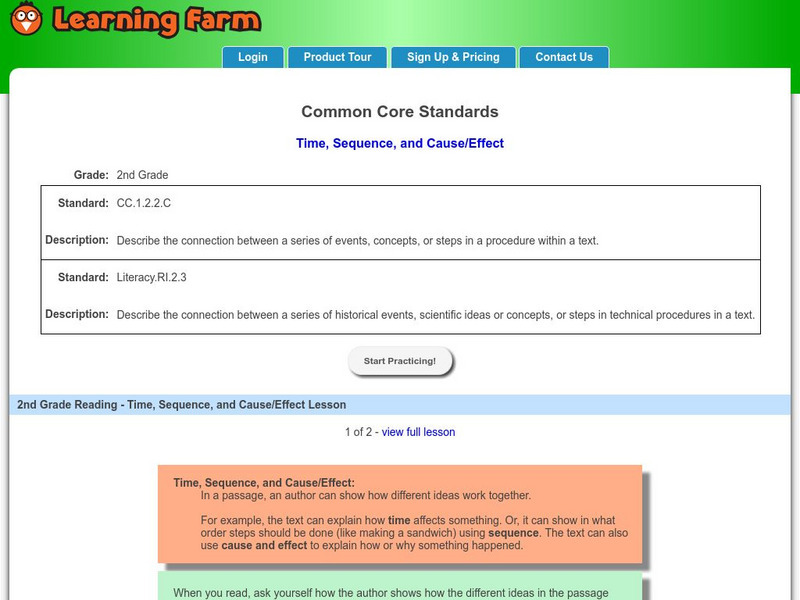
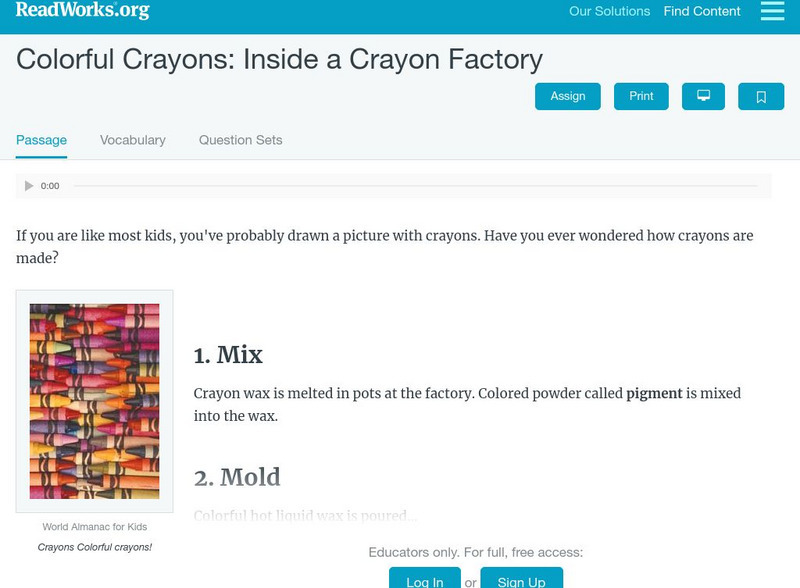
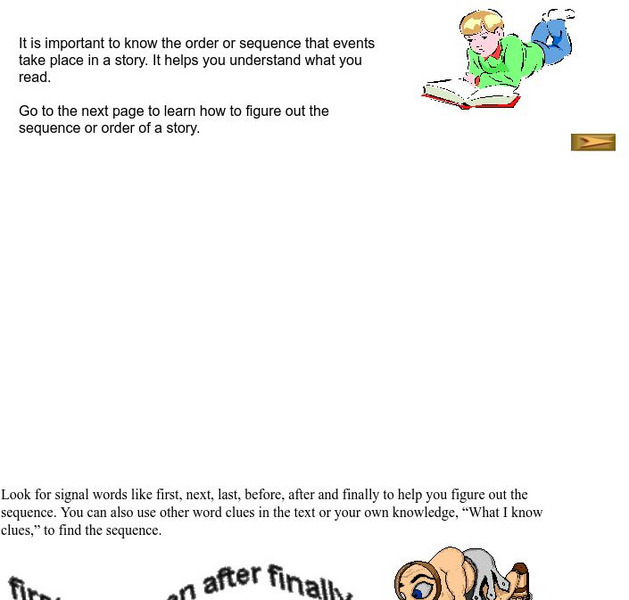

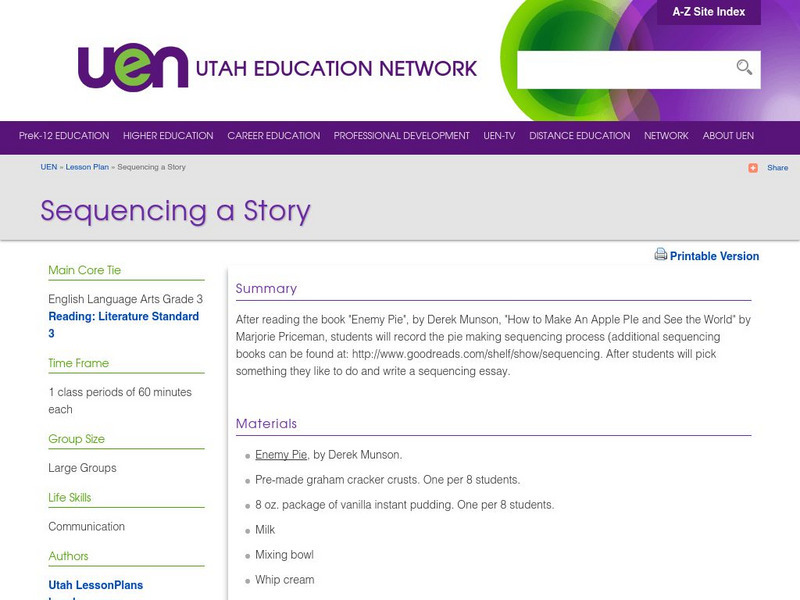
![Texas State Historical Association: Depression to Prosperity [Pdf] Lesson Plan Texas State Historical Association: Depression to Prosperity [Pdf] Lesson Plan](https://d15y2dacu3jp90.cloudfront.net/images/attachment_defaults/resource/large/FPO-knovation.png)
